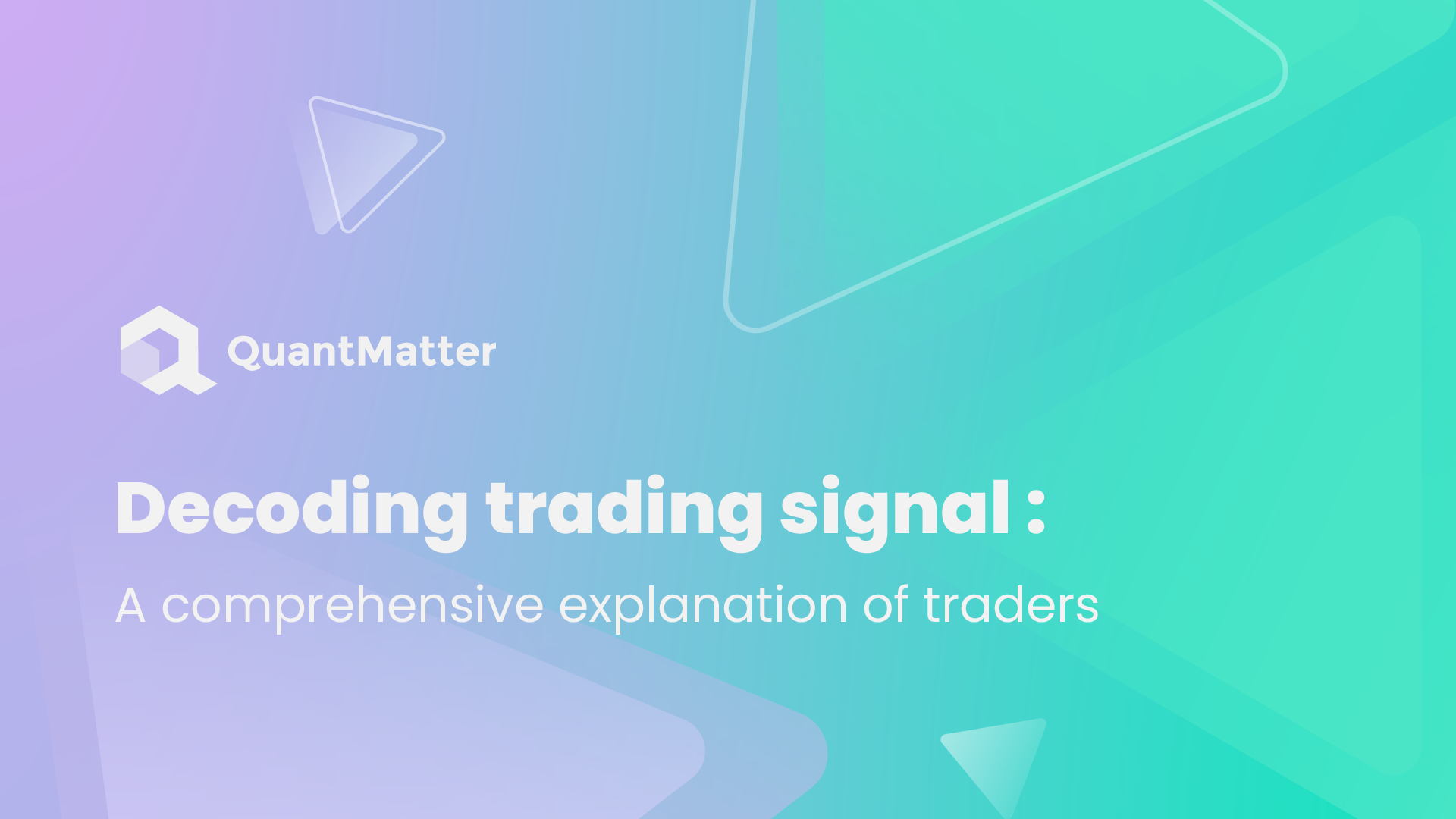
The financial market is based on trading signals that form its cornerstone for different traders. The vitality of informed decision-making is evident in the trading world in these signals that are often created using technical and fundamental analysis, which also incorporates many algorithms.
Trading signals are at the core of the financial markets, as their core beat drives traders action in stocks, Forex, commodities, cryptocurrencies and various other asset classes. They provide an important platform for understanding the complex realm of assets, highlighting possible prospects and dangers. A trading signal is important as it helps decode the complex puzzle of market behavior and changing price trends.
The financial markets depend on trading signals, just like the heartbeat on which life depends. These people provide necessary information regarding changing asset prices such as stock, foreign exchange, cryptocurrency, and commodities, which helps the traders. The next section of this discussion will expound in further detail on the issue of trading signals, providing a comprehensive examination.
What Are Trading Signals?

The financial market is an important point where trade signals are so significant since traders can utilize these signals in making their trading decisions. Basically, these signals point out how to take up and sell trading items in a challenging financial market environment.
Technical and fundamental analysis constitute one of the main procedures for generating trading signals. Technical analysis is based on historical price charts, patterns, and several technical metrics that help predict the next directional movement or change in prices. However, the basic analysis focuses on the monetary position and activities of an asset, as it includes elements such as company earnings, macroeconomic indicators, and geopolitical developments, among others. This helps in bringing together both methods to create an integrated impression of the industry.
Trading signals are also generated using algorithms. Trading robots are sophisticated algorithmic trading systems that take into account specific inputs in order to execute auto-trades as per set values and criteria. The algorithms are speedy and can handle huge amounts of data to make instantaneous decisions, which is why they are so popular with high-frequency transactions.
Sometimes, trading signals are driven by expert views. Traders or expert financial analysts may give some views and opinions about the entry or exit of any trade they have an idea about. These are very useful observations, especially when they come from reliable sources who have been successful investors in the financial market.
Some of these sources include people, some financial institutions, and some even automated trading systems. Traders usually pay for signaling services from experts and trading companies whose signals go straight to their trading terminals or mobile devices. This enables the traders to take immediate action.
Trading signals are generated under different criteria and parameters, depending on the circumstances at hand. The signals may be derived from simple indicators like moving averages and relative strengths, or they may even go into sophisticated combinations of both technical and fundamental factors. A trader’s strategy, risk tolerance, and investment purpose determine which cues to follow when making such a decision.
To conclude, trading signals are essential tools for traders and investors that provide them with orientation in the complex world of financial markets. These methods combine technical analysis tools, algorithm-based systems, and professional tips to suggest when trades should be made. Regardless of whether one is a trader or a professional, it is important to comprehend how it works.
How Do Trading Signals Work?

Trading signals are important pointers for traders that help them buy or sell with great caution in the complex world of financial markets. The first stage of these signals involves the accumulation of a wide variety of data on prices, trading volumes, the economy, firms’ accounts, and any news events within the market arena. They look at the historic charts of price and other technical indicators like the moving averages and relative strength index for these purposes. Trade signals base their assumptions on past market data in order to identify any pattern that could lead to an anticipated price shift. Here’s a breakdown of how they operate:
- Data Collection
In this case, market data collection becomes the basis for trading signal generation. Gathering vast data related to the investment under analysis. This information involves past prices and is depicted through the candlesticks/line chart or by stating the amount traded in a certain period.
Economic indicators such as price and volume also form part of the collected data. Comparator unemployment rates, GDP growth, or inflation figures may constitute the indicators. Such data can be collected in order to have a broader overview of the performance of the underlying asset.
- Analysis
Technical analysis constitutes an important part of the analysis phase. There are numerous types of technical instruments and indices that traders employ, for instance, EMA (exponential moving average), RSI (relative strength index), or MACD (moving average convergence divergence) to discern price-chart patterns and trends. The study involves the analysis of old data in reference to possible breakout points as well as looking at common chart patterns such as head and shoulders and additional technical indicators depicting possible price direction.
In contrast with such a technique as fundamental analysis, an investigator should go beyond charts and reveal some factors that can influence the value of a financial instrument. Economic information, business news, corporate pprofitstatement and even political issues of various kinds contribute to this development. The idea of fundamental analysis is about estimating the true value of an element, whether underpriced or overpriced.
Also Read: Market Making: Strategies and Techniques
- Signal Generation
This is where the rubber hits the road during the signal generation phase. This is a stage where an analysis is transformed into tradable orders or signals. A technical analysis could show a crossover in two moving averages, which could be a strong bullish signal that should make one buy. Firstly, in the fundamental aspect of trading, some positive reports about the earnings of a company or an optimistic attitude toward a country’s economy may be a stimulus to acquire a long position in a stock or currency pair.
The number, nature, and specifications of signals are closely related to the trading approach as well as individual traders’ tastes. Traders could look at simple, defined signals or opt for mixed signals involving both technical and fundamental indicators.
- Delivery
Trading signals must be effectively conveyed to the traders immediately once they are generated. That is usually implemented via mail or text, and possibly the system is directly integrated into the trade platforms. Such messages are delivered to subscribers of the signal services through a choice of medium, enabling quick action on the information.
Traders should choose a method of delivery as per their tastes and trading style. For some, there are real time alerts on their trading platforms, while others can choose to have their respective emails analyzed at an appropriate, convenient time.
Multiple Perspectives on Trading Signals

The trading signals are reviewed from different angles, bringing their respective approaches to the intricate aspects of the financial market. Technical analysts focus on historical prices and patterns because they believe that trading signals extracted from technical indicators like moving averages and relative strength indexes can signal future pricing behavior. On the other hand, fundamental analysts depend on economic and company data. Their trading signals are based on robust fundamentals like economic indicators and earnings reports.
On the other hand, there are quantitative traders who see everything mathematically, and their trading is algorithm-driven where they use complicated models to get signals. A trading signal is multifaceted, depending on how one views it in the market environment. The different opinions of the dealers show their diverse approaches, tolerance for risks, and personal opinions. Let’s explore some of these perspectives:
– Technical Analysis Enthusiasts
This is what technical analysis enthusiasts have faith in, whereby they believe that historical price movements are very instrumental towards understanding the future movements of prices. Price chart analysis is taken very seriously, as they look for common occurrences in these charts, support/resistance levels, and different technical indicators.
In their toolbox, they have key technical indicators like moving averages, smooth out price data, and identify trends over time. Another indicator that is commonly utilized in measuring overbought and oversold positions is known as the Relative Strength Index (RSI). MACD is also commonly used for trend-following as well as momentum. They use technical analysis tools to determine points of entry and exit depending on past price series patterns. For instance, they assume that a trend will either continue or change, and this can be utilized to make profits.
– Fundamental Analysis Supporters
Supporters of fundamental analysis advocate intrinsic value in financial assets and regard trading signals backed by firm fundamentals as grounds for decisions over the long run. They dig deep into macroeconomic statistics, the state of the companies, and any market news in order to judge the sustainability and profitability of these assets.
The state of economies and the value of currencies are closely monitored through economic indicators like GDP growth, inflation rates or employment figures. The assessment of company-specific data, like earnings and strategies in management, helps identify the success prospects of separate shares. These traders usually operate with a longer view, seeking to uncover mispriced stocks and investing in them, relying largely on macroeconomic fundamentals.
– Quantitative Traders
Sophisticated models and numerical schemes provide quantitative traders with trading signals. They approach their operations systematically. They conduct a statistical analysis to find commonalities in financial market data.
This approach is ideally suited to high-frequency businesses because they can handle large loads of data at fast rates. Such are automated, for they decrease the chances of any emotional bias that can slow down trade executions. Quantitative traders can either build up a program or employ ready-made solutions for quantitative trading using the power of numerical analytics for a decision making.
Also Read: What Is a Quant? Everything about Quantitative Analyst
– Contrarian Investors
A contrarian investor is different in that he or she will purposely oppose market sentiment. In this case, they apply trading signals to detect abnormal instances of overbought and oversold assets. They believe markets eventually “mean-revert” and therefore base their strategy on this assumption.
For instance, a contrarian investor will find purchase opportunity in case a trading sign shows that stock is unbelievably oversold (by basis of either fundamental or technical analysis). Other buyers will realize that the stock is undervalued, and they will buy it thinking that the price will rise again in the future. Contrarian trading requires faith in analysis and endurance during the swings of markets up or down, hoping that the sentiments will change.
– Expert Opinions
Well-known analysts and economists whom traders highly regard offer trading signals to traders who value experts’ opinions. They are made up of experts with rich experience that helps them give advice while learning about market dynamics.
Expert opinion might combine both technical and fundamental analysis with reference to the total analysis of the market situation. Nevertheless, traders should exercise due diligence and not take expert opinions at face value because experts are fallible too, and each case is unique.
Conclusion
Trading signals are necessary because traders need to be well informed when making critical decisions in a volatile world. They present different types of signs, each having distinct strengths and weaknesses. A trader’s success in the market often depends on his capacity to recognize these signals and utilize them appropriately. Indeed, successful commerce does not just depend on signals. However, it’s how you interpret the indicators and whether or not you can adjust them to your kind of trade as well as your appetite for risk.
Trading signals are not specific to one way of trading, but rather there are many approaches to how to trade that use signals as an integral part of their methodology. The art of successive trading is based upon the mastery of applying these signals within a specific approach, whether technical analysis, fundamental analysis, quantitative trading, contrarian investing, or following expert opinion. Through matching your way of trading to your type of trading, risks and tolerance, the trading signals may assist you in sailing through and prospering in the multi-dimensional environment of the financial market.
Disclaimer: The information provided by Quant Matter in this article is intended for general informational purposes and does not reflect the company’s opinion. It is not intended as investment advice or a recommendation. Readers are strongly advised to conduct their own thorough research and consult with a qualified financial advisor before making any financial decisions.

I craft stories that make complex ideas clear. I simplify the blend of data science, machine learning, and crypto trading, showcasing how advanced tech and quantitative models analyze data for informed trading choices. Join me in exploring the realm of quantitative trading, where my narratives make intricate concepts easy to grasp.
- Alifia Berizkyhttps://quantmatter.com/author/alifia-berizky/
- Alifia Berizkyhttps://quantmatter.com/author/alifia-berizky/
- Alifia Berizkyhttps://quantmatter.com/author/alifia-berizky/
- Alifia Berizkyhttps://quantmatter.com/author/alifia-berizky/
